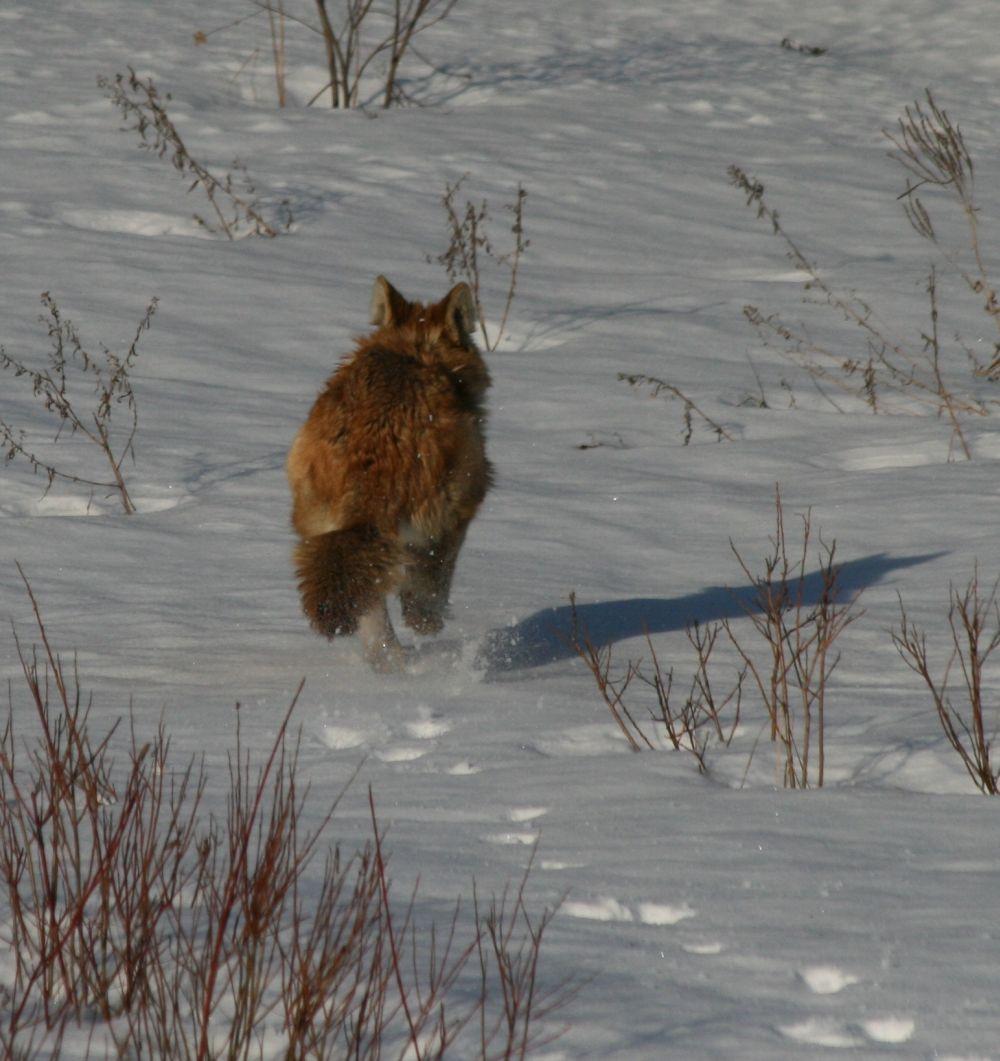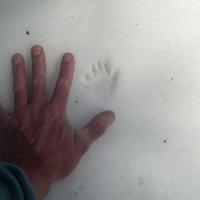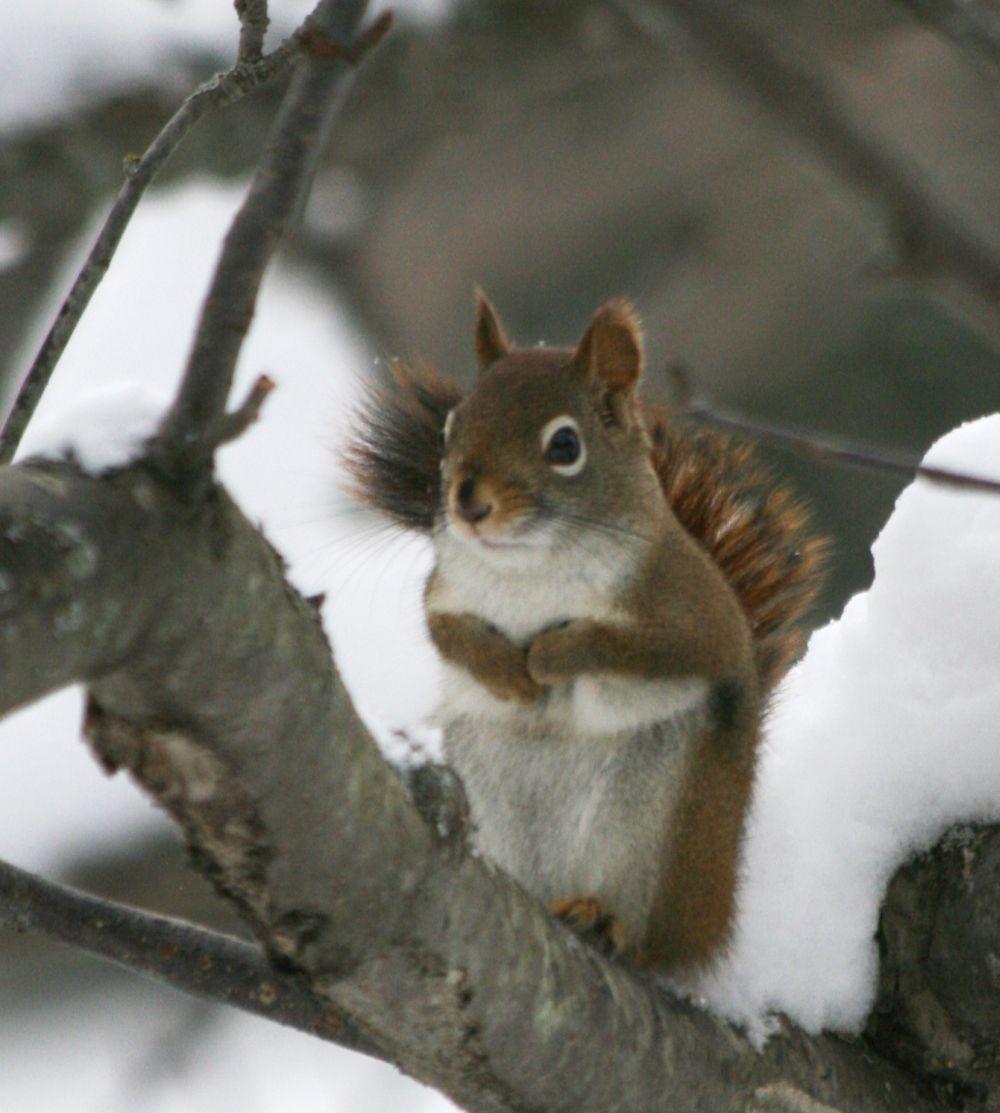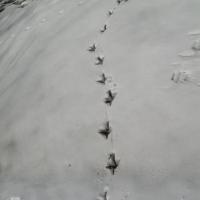Nature's View
- Tags:
- Wildlife

A red fox making tracks. Photo Ben Hudson
Much more than tracks in the snow
When snow returns to the forest, wild neighbors guide me through a winter of changes.
The first measurable snowfall of winter stops me cold in my tracks. I stare at a landscape instantly transformed into a Currier and Ives print, the classic New England cliché. Before grim realities of weekly shoveling, plowing, and hauling cordwood intercede, I experience a jubilant, schoolboy response: an irresistible impulse to pack and hurl that first winter snowball.
First snowfall is not sinister; those darker connotations await the end of winter. I suspect the reverse is true for my wildlife neighbors suddenly faced with new challenges. Snow highlights the adaptations necessary for winter survival, complicating travel and making food, water, and shelter more difficult to find. Snow is why some wildlife—and people—have adapted to enter a winter torpor, hibernate, or migrate south.
In December I relearn the art of tracking the wildlife that traverse my woodlot in the pre-dawn hours following a fresh snowfall. Snow provides a blank canvas where wildlife activities are recorded, irrefutable proof of which species are present and what they are doing: browsing, hunting, fleeing, hiding, resting, or seeking mates. It is particularly interesting to see how this activity changes with food supplies, weather, and snow depth as winter progresses. I measure my own winter’s progress as tracks meander, bee-line, disappear, and pair-up during the February and March breeding season for many fur-bearers. Backyard birdfeeders become a supermarket where hungry bobcats or owls await unsuspecting squirrels.

Most commonly, I find tracks of white-footed and deer mice, gray squirrels, turkeys, porcupines, foxes, coyotes, and deer—lots and lots of deer. With luck over the course of the winter, I eventually find tracks of wildlife less common to my woods: snowshoe hare, ermine, fishers, otters, bobcats, and moose. By late winter, emerging chipmunks, skunks, raccoons, and bears foretell of springtime.
Tracking facilitates the identification of far-ranging predators along their favorite hunting circuits. Coyotes, foxes, fishers, and owls hunt red-backed voles or white-footed mice beneath the snow and leave telltale plunge holes. When deep enough, snow conceals and insulates the “subnivian” lifestyle of wildlife that construct a labyrinth of tunnels beneath the surface: weasels, red squirrels, mice, voles, and shrews. Up above, snowshoe hares and short-tailed weasels are camouflaged by the snow.

December deer tracks reveal where deer dig by night and turkeys till by day, scattering oak and beech leaves while scratching beneath the snow for acorns and beechnuts. The December deer are apt to be anywhere after hunting season closes. As winter progresses and the snow pack deepens, the steep south-facing slopes under the oaks are preferred acorn foraging sites. Deer experience more difficulty traveling in deep snow than their longer-legged ungulate cousins, moose, which are better adapted to wading deep drifts. Shallow snow depth and meager mid-day sunshine help the deer to conserve precious heat calories.
By January, a closed canopy of thick pine, spruce, or hemlock boughs intercepts falling snow. These “deer yards” become favored haunts of deer, which can travel through the reduced snow depths beneath with less wallowing. A thick canopy of softwoods also insulates them from radiational cooling on cold nights when winter wind and temperatures under naked hardwood branches are more extreme outside the shelter of the deer yard.
In February, lone fox tracks often suddenly pair-up as breeding season begins. The frequent territorial urine scent posts of the male fox may be accompanied by the blood in the snow of a vixen entering estrus. Normally solitary, fishers and red squirrels also pair-up for mere hours during breeding before resuming their generally mutually-antagonistic existence. So much for Valentine’s Day romance!

When the snow pack reaches its maximum, open springs or hillside seeps become winter oases in a surrounding expanse of snow and ice. Many wildlife species—particularly huge winter flocks of turkeys—frequent areas that do not freeze due to groundwater seepage. I find muddy tracks on the snow leading away from springs that are fringed with the exotic green of haircap moss and sphagnum moss.
By March, coyotes emboldened by hunger become more prominent in nightly pursuit of winter-weakened deer. Deer movements become more erratic as hunger and flight from coyotes and an occasional bobcat push them out of their sheltered deer yards. As the snow pack softens in strong late winter sunshine, coyotes prepare to give birth to their pups.
The most reliable sign of spring is the song of a Brown Creeper and the emergence of chipmunks from their winter dens. Red squirrels nip buds from twigs of sugar maples and red maples to lap sap—a sweet reward after a long winter of tunneling in solitude beneath the snow to reach buried caches of hemlock and spruce cones. Gray squirrels emerge from communal dens and leaf nests to chase one another, barber-pole fashion, during their March breeding season.
The final act in April features muddy tracks of emerging black bears crossing from bare ground under hardwoods onto shrinking patches of snow in conifer shade. Muddy bear tracks signal the end of winter, a progression of wildlife tales that began with those first tentative flakes of winter. If I pace myself, I too may survive to squint in that warm April sunshine.
